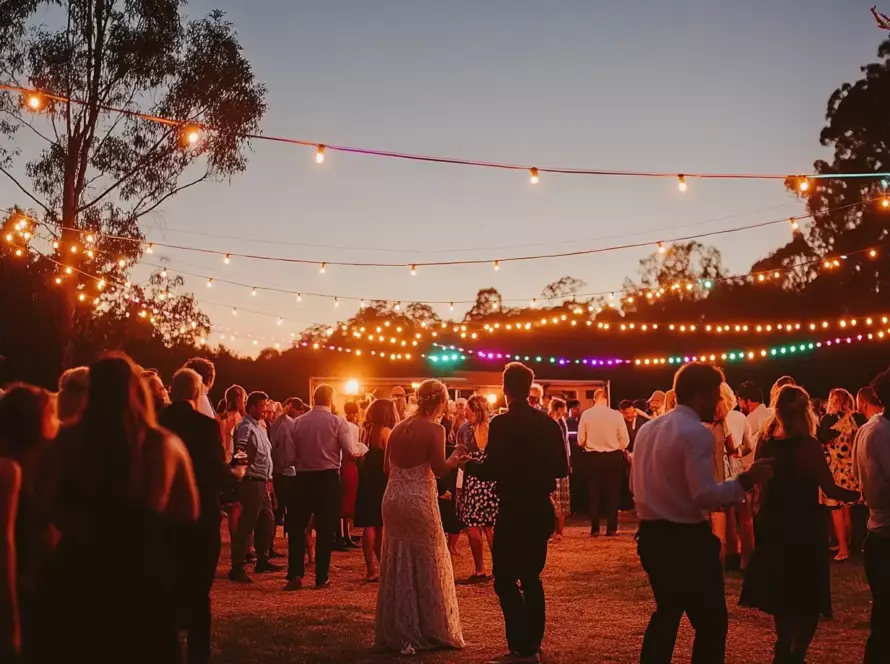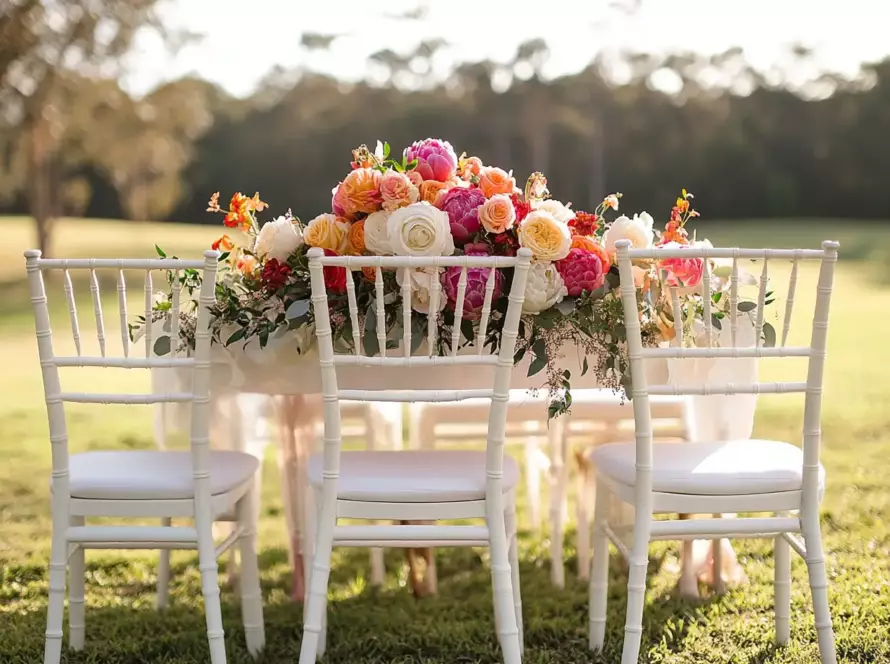Planning a perfect wedding day requires more than just picking a date and booking vendors.
It’s about ensuring each moment unfolds effortlessly, from the first look to the final dance.
By creating a seamless wedding day timeline, you’ll keep everyone on track, reduce stress, and give yourself time to enjoy every second of your celebration.
Table of Contents
Why a Detailed Timeline Matters
A well-planned schedule helps you sidestep last-minute chaos, prevents vendor miscommunications, and ensures a stress-free wedding from morning prep to the grand exit.
- Sets Clear Expectations: Your wedding party, DJ, and photographer know exactly where to be and when.
- Reduces Overlaps: No more frantic rushing or too-long downtime between ceremony and reception.
- Improves Guest Experience: A steady flow keeps everyone engaged and entertained.
If you want your day to unfold like clockwork, give as much attention to wedding schedule tips as you do to your décor and dress.
Building the Foundations of Your Schedule
Consider Your Venue and Season
Outdoor ceremonies might need more flexible timing due to weather or daylight constraints. Venues often have strict start/end times, so confirm your access hours before finalising details.
List Major Segments
Divide your day into broad categories:
- Hair and Makeup
- Ceremony
- Cocktail Hour
- Reception (Dinner, Speeches, Dancing)
- Send-Off
Ensuring each segment flows seamlessly is key to a cohesive timeline.
Prioritise Vendor Input
Vendors have insider knowledge—photographers know how long family portraits can take, and DJs are experts at pacing a reception. Incorporate their insights early for a more accurate timeline.

Key Milestones and Timing Suggestions
While every wedding is unique, here’s a general structure you can customise:
Getting Ready (3–4 hours)
- Hair and makeup for the bride and bridesmaids
- Groom and groomsmen final touches
- Photographer arrives for detail shots (dress, rings, etc.)
First Look or Pre-Ceremony Photos (Optional; 30–60 minutes)
- Private moment between bride and groom
- Immediate family or bridal party photos to save time later
Ceremony (20–40 minutes)
- Guests seated 15 minutes before start time
- Processional, vows, recessional
Cocktail Hour (60 minutes)
- Light refreshments and small bites
- Opportunity for more photos (couple and extended family)
Reception Entrance & Dinner (2–3 hours)
- Bridal party/parent entrances
- Dinner service or buffet
- Speeches and toasts
Dance Floor & Formalities (2–3 hours)
- First dance
- Parent dances
- Cake cutting
- Open dance floor
Send-Off (Optional; 15 minutes)
- Sparkler exit or car send-off
Use these estimates as a guideline. If you’re hosting multiple events (e.g., cultural traditions or multi-course meals), add extra buffer time.
Coordinating Ceremony and Reception
Bridging the gap between your ceremony and reception is a common challenge.
You don’t want guests waiting around with nothing to do, but you also need time for photos and any necessary venue setup changes.
Ways to Keep Guests Engaged
- Cocktail Hour: Provide drinks, appetizers, or light background music.
- Lounge Areas: Comfortable seating for guests who’d rather relax than mingle.
- Interactive Activities: Consider a photo booth or lawn games if there’s outdoor space.
Venue Logistics
If your ceremony and reception are at different locations, factor in travel time.
This is especially crucial if you’re planning to do a photo shoot en route.

Working with Your DJ and MC
A seamless wedding day timeline often hinges on how well you’ve planned your music and announcements.
- Playlist Cues: Share any must-play songs for the ceremony, cocktail hour, and reception well in advance.
- Schedule Coordination: Your DJ or MC can announce transitions (e.g., from cocktail hour to dinner) and keep guests informed of key moments like the first dance or speeches.
- Technical Considerations: Check sound system needs for indoor vs. outdoor spaces. Some venues have noise restrictions, so confirm volume limits or cut-off times.
Stolen Dance Entertainment specialises in guiding you through these steps, ensuring your music aligns perfectly with each part of the day—creating a cohesive flow that guests will appreciate.
Tips for a Stress-Free Wedding Day
Delegate Wisely
Assign a trusted friend or coordinator to handle minor errands. The bride or groom shouldn’t be rushing around chasing up vendors or lost guests.
Create a “Buffer Zone”
Allow extra time between each major event. If things run behind, it won’t derail the entire schedule. If you’re on time, you can relax and enjoy a moment with your bridal party.
Communicate Clearly
Send your timeline to all relevant parties (wedding party, family members, vendors) at least a week before the wedding. Follow up with any changes.
Practice Your Transitions
Simple run-throughs for the processional and recessional can prevent awkward shuffling. This is especially helpful if you have children in your wedding party.
Common Timeline Pitfalls to Avoid
- Overloading the Day: Scheduling every minute without breaks leads to stress and exhaustion.
- Ignoring Travel Times: Even short distances can consume more time than expected, especially in peak traffic.
- Skipping Vendor Meals: Plan when key vendors (photographer, DJ, coordinator) can have a quick bite to avoid burnout.
- No Fallback for Weather: Outdoor weddings require Plan B for rain or extreme heat.
- Forgetting the Final Farewell: Plan how you’ll exit—sparklers, bubbles, or a private moment—so guests know when the night ends.
FAQs About Wedding Day Coordination
How many songs do I need for the entire wedding day?
Aim for 4–6 weeks before the wedding, giving you enough time to adjust for any last-minute venue or vendor updates.
Do I really need a day-of coordinator?
If you can budget for it, a coordinator can be invaluable for managing unexpected hiccups. Otherwise, assign a trusted friend or family member.
How can I keep my reception on schedule?
Your DJ or MC can make brief, fun announcements about the next activity (cutting the cake, first dance, bouquet toss) so everyone knows what’s happening.
Should I provide meals for vendors?
It’s considerate—and often contractual—to supply vendor meals, especially for those working more than 4–5 hours. Coordinate with your caterer to include them in the headcount.
How do I handle time overruns?
Add 10–15 minutes of buffer between events. If you see you’re falling behind, communicate swiftly with your DJ, MC, and coordinator so they can keep things smooth.
Final Thoughts
A seamless wedding day timeline empowers you and your loved ones to focus on what truly matters: celebrating love, laughter, and new beginnings.
By carefully plotting out each moment—from hair and makeup to the last dance—you set the stage for a day that feels as effortless as it is memorable.
Remember, flexibility is key. Embrace the occasional hiccup, trust your vendors, and keep lines of communication open.
With a strong plan in place, you’ll glide through your wedding day feeling calm and confident—and your guests will be talking about the experience for years to come.


